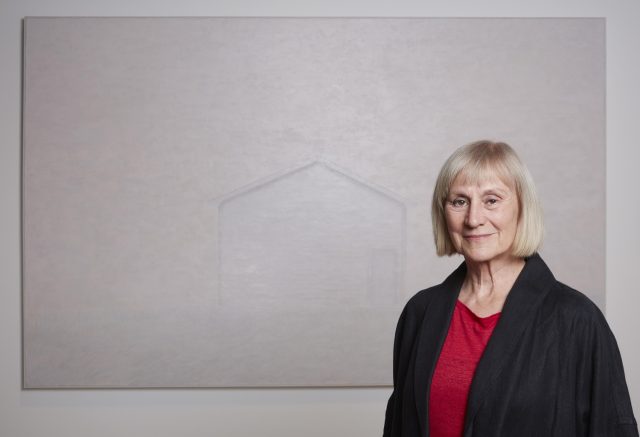To the lighthouse

On the southeastern-most tip of Newfoundland, there is a lighthouse on a cliff. When Canadian artist Leslie Reid first arrived at Cape Pine in 2008 for a month-long artist residency, the fog was so thick she couldn’t even see the lighthouse. But the fog and the lighthouse would both inspire her work.
Recently acquired by the AGO and on view now in the new J.S. McLean Centre for Indigenous & Canadian Art, Cape Pine: The Station is one in a series of three large paintings named after this remote place. We sat down with the artist to learn more about this mesmerizing work, and the tragic story behind the evocative setting:
AGO: What struck you most about Cape Pine?
Leslie. My introduction to it was a mystery that only gradually revealed itself. Before visiting Cape Pine, I had never been to Newfoundland. On the day I arrived, because the fog was so thick, I didn’t know where the sea was, or where the road began and ended. Luckily, the fog only lasted three or four days, but that initial experience struck me intensely - partly because it was like walking into one of my early paintings, where through using spray paint, and only suggesting a horizon I had, for a time, tried to create a sensation of being enveloped by light.
AGO: Some would consider this a very haunting image. Do you see it that way?
Leslie: Most of my work is preoccupied with evoking a sense of lived lives in the landscape. Cape Pine is a lived-in landscape. From the start, I was aware of a strong presence of family. I learned that three members of the light keepers’ family – the lightkeeper, his 16-year-old son and his brother-in-law – all tragically drowned there in the 1980s. Along with paintings, I created a video piece about the paths the family had walked, marking their presence in the landscape.
AGO: Your painting gives fog an almost physical weight. How did you achieve that?
Leslie: I tried to capture the fog on video, and took photos of what I thought I could see in the fog, with the idea of making paintings from them. When I looked at the photos and video, I knew that I wanted to evoke the all invasive presence of the fog. It took about eight layers of paint and various tools to create the soft edginess I was after, to create a luminous whiteness that comes through the building (the fog alarm station) and holds the building in its arms.
Don’t miss this and other exciting works by Canadian women artists on view now in the J.S. McLean Centre for Indigenous & Canadian Art, free with General Admission.
Are you an AGOinsider yet? If not, sign up to have stories like these delivered straight to your inbox every week.
The installation of the AGO’s Indigenous & Canadian Collection is generously supported by
Andrew & Marianne Guizzetti
Robert Harding & Angel Yang
The McLean Foundation

